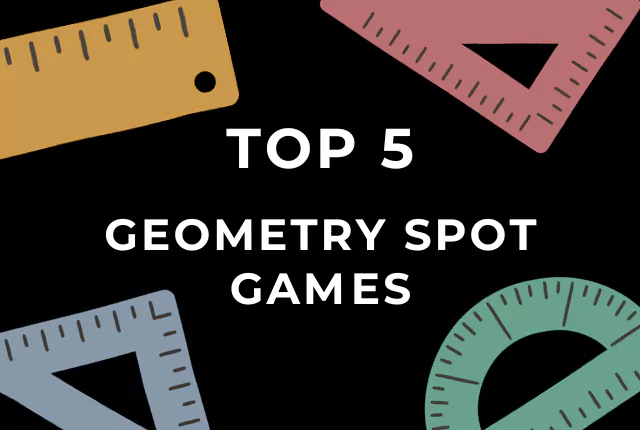Geometry, the branch of mathematics that deals with shapes, sizes, and the properties of space, has always been a captivating subject. From the simplicity of lines and circles to the complexity of three-dimensional objects, geometry holds a fundamental place in understanding the world around us. The term “Geometry Spot” serves as a metaphorical window into this intricate realm, where shapes and spatial relationships converge, offering both mathematical elegance and practical applications.
Understanding Geometry Spot
What is Geometry Spot?
Geometry Spot refers to the exploration and study of geometric shapes, patterns, and spatial configurations. It involves investigating the properties, measurements, and relationships between various shapes, lines, angles, and solids. This exploration extends to both theoretical understanding and practical applications in fields such as architecture, engineering, art, physics, and more.
Why Explore Geometry Spot?
Geometry Spot serves as a gateway to understanding the fundamental principles that govern our physical world. By delving into the intricacies of shapes and space, one gains insights into natural phenomena, structural designs, technological advancements, and artistic creations. Understanding geometry can enhance problem-solving skills, critical thinking, and spatial reasoning abilities.
Areas of Focus within Geometry Spot:
- Euclidean Geometry: The study of geometric shapes and their properties based on Euclid’s axioms and principles.
- Analytical Geometry: Utilizing algebraic techniques to study geometric shapes and their equations.
- Solid Geometry: Investigating three-dimensional shapes such as cubes, spheres, cylinders, and their properties.
- Differential Geometry: Examining properties of curves and surfaces using calculus techniques.
- Topology: Studying properties of space that are preserved under continuous transformations.
Exploring the Wonders of Geometry Spot
Applications in Everyday Life:
Geometry finds practical applications in various fields. In architecture, it assists in designing structures with optimal stability and aesthetics. Engineers use geometric principles to develop machines, bridges, and infrastructure. Moreover, in art and design, geometry plays a crucial role in creating visually appealing compositions and patterns.
Mathematical Beauty and Elegance:
One of the most alluring aspects of geometry is its inherent beauty and elegance. The symmetrical patterns of a snowflake, the perfect harmony of a circle, or the intricate shapes found in nature exemplify the captivating allure of geometric forms.
Problem-Solving and Critical Thinking:
Geometry Spot encourages problem-solving skills and fosters critical thinking. By tackling geometric puzzles and theorems, individuals enhance their logical reasoning abilities and develop a structured approach to problem-solving.
Contributions to Scientific Advancements:
Geometry has significantly contributed to scientific discoveries and technological innovations. Concepts like calculus, used in physics and engineering, rely heavily on geometric principles. Additionally, space exploration, GPS technology, and computer graphics owe their advancements to geometric algorithms and theories.
Challenges and Ongoing Research:
Despite centuries of exploration, geometry continues to pose intriguing challenges. Questions regarding the nature of space, higher-dimensional geometries, and the unification of geometry with other branches of mathematics remain areas of active research and exploration.
FAQs
1. How does geometry impact technological advancements?
Geometry forms the backbone of many technological advancements. From the design of computer graphics and animations to the development of algorithms in robotics and artificial intelligence, geometry plays a vital role in shaping modern technology.
2. Is geometry only relevant to mathematics?
While geometry is a fundamental part of mathematics, its applications extend far beyond. It influences various disciplines such as physics, engineering, architecture, computer science, art, and even biology.
3. What careers benefit from a strong understanding of geometry?
Careers in architecture, engineering, graphic design, computer programming, surveying, and physics greatly benefit from a robust understanding of geometry. Professions involving spatial reasoning and problem-solving often require a strong foundation in geometric principles.
4. How does geometry inspire creativity?
Geometry provides a framework for creative expression in various art forms. Artists, designers, and architects use geometric principles to create visually appealing compositions, patterns, and structures that evoke aesthetic beauty and harmony.
5. Are there real-life examples of higher-dimensional geometry?
While humans experience and comprehend three dimensions, theories in physics and mathematics, such as string theory and multidimensional spaces, suggest the existence of higher dimensions. However, visualizing and understanding higher-dimensional geometry remains a theoretical challenge.
Conclusion
Geometry Spot represents not just a location of mathematical exploration, but a lens through which we perceive and comprehend the world’s fundamental structure. Its relevance spans across disciplines, impacting scientific discoveries, technological innovations, and creative endeavors. By delving into the complexities of shapes and space, one gains not only a deeper understanding of mathematics but also a profound appreciation for the elegance and beauty present in our universe.



